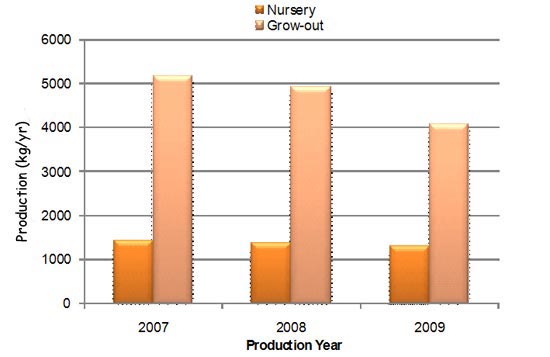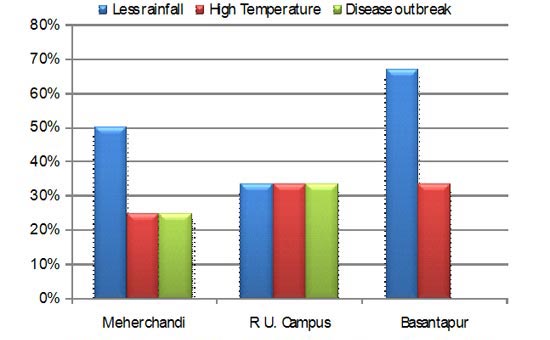
Background:
Climate change is considered as one of the important themes in recent years worldwide. Fisheries sector contributes to improve the rural livelihood which is threatened by climate change that decreases production, affects human health and destroy physical assets. So, climate change is a pressing development challenge for Bangladesh in view of the country’s vulnerability to its impacts. Addressing climate change concerns has thus become urgent and a priority issue for continuing the country’s development activities, especially in Rajshahi region because Rajshahi area is considered as one of the low output zones in terms of agricultural production. In addition to, the quality of soil and water, climate change aspects (especially drought) leads the farmers of this region more vulnerable as compared to other parts. The present study aimed to assess the impact of environmental fluctuation on fish production of seasonal ponds at Rajshahi area.
Methodology:
The study was conducted in 10 seasonal ponds situated at Meherchandi, Rajshahi University campus under Matihar Thana and Basantapur under Godagari Upazilla for a period of 1 month in September, 2009. Representative sample farmers were selected randomly. To collect the secondary information, an exploratory visit was conducted to the study areas. Data of different climatic parameters were collected from the regional Meteorological Station, Shyampur, Rajshahi. Collected data was cross-checked. Finally, all the data were subjected to descriptive analyses using the computer software MS Excel to understand the differences of the variables among the different years.
Findings:
Climatic parameters:
The average rainfall in 2007, 2008 and 2009 are 1505.9 mm, 1158.9 mm and 1047.6 mm respectively. The average water temperature in 2007 is 30.94 0C, while in 2008 and 2009 are 31.20 0C and 32.03 0C respectively. The relative humidity in 2007 is 79.31%, while 79.50% in 2008 and 77.63% in 2009.

Fish production:
Grow-out pond: Average fish productions from the grow-out ponds in 2007, 2008 and 2009 respectively are 5179 kg, 4917 kg and 4088 kg. The fish production is lower in 2009 and this is probably due to reduced rainfall, higher water temperature, scarcity of water, higher water turbidity, out-break of diseases etc.
Nursery pond: Average fish productions from nursery ponds in 2007, 2008 and 2009 are 1438.36, 1374.76, 1312.11 kg/ha respectively. The fingerling production in nursery ponds is lower in 2009. It is probably due to higher water temperature, reduced rainfall, scarcity of surface water, higher water turbidity, outbreak of diseases etc.

Causes of fish production fluctuation:
Different causes of fish production fluctuation were reported by fish farmers during the survey which are less rainfall, higher temperature, disease outbreak etc. Therefore, the average fish production in recent year is found as a great reduction in unsatisfactory levels. Data for causing fish production fluctuation were recorded from the study areas showed in the following fig.

In the visited areas, almost all types of fish seed were collected by fish farmers from the local hatchery. But during the survey, farmers could not prepare their pond due to surface water unavailability. For this reason, they collected fish seeds and released in the ponds after peak period. As a result, the growth rate of fishes was hampered and ultimately, the average fish production was reduced.
Conclusion
Although, Bangladesh is one of the most climate vulnerable countries, appropriate technology has not adopted or developed yet. The study highlights marked differences in the impact of environmental fluctuation on fish production in Rajshahi areas than that of previous years. Considering the climatic aspects, we must seek to improve yields by ways that leave the natural resource base intact.
Recommendation:
Following recommendations are suggested for the development of fish production of seasonal ponds in the Rajshahi area:
- Steps should be taken to create adequate number of surface water reservoirs for irrigation purposes and recharging the ground water resources.
- High resistant fish species should be cultured to minimize the risk.
Acknowledgement:
Dr. Akhtar Hossain, Associate professor, Department of Fisheries, University of Rajshahi, Rajshahi-6205, Bangladesh.
References
- Ail, A. 1996. Vulnerability of Bangladesh to climate change and sea level rise through tropical cyclones and storm surges. J. Water Air Soil Pollut. 92d: 171-179.
- Ali, A. 1999. Climate change impacts and adaptation assessment in Bangladesh. Clim. Res., 12: 109-116.
- Boyd, C. & Zimmermann S. 2000. Grow-out systems-water quality and soil management. pp. 221-238. Blackwell Science. Oxford, Uk.
- Hossain, M. A. 2008. Potentials of khas ponds and kharis in Barind areas: Sustainable rural livelihoods in the face of climate change. ASHRAI, 152/3 Uposhahar, Rajshahi, p. 4.
Visited 929 times, 1 visits today | Have any fisheries relevant question?
